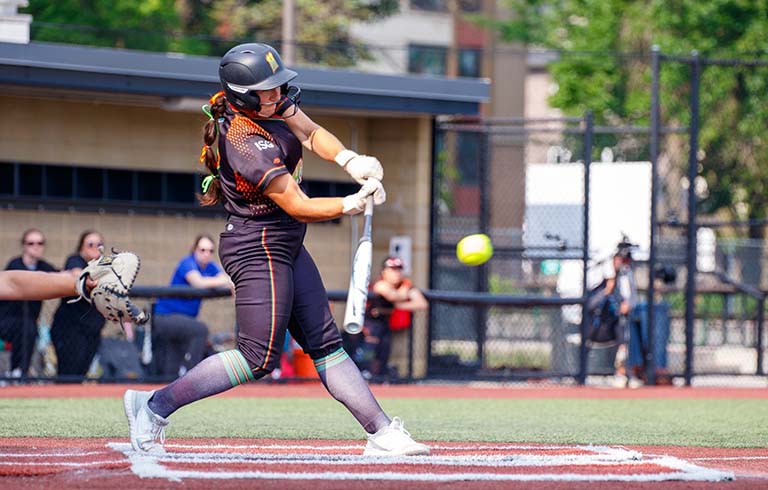
The game goes on: Trine softball players enjoy summer with Habaneros
For two members of Trine University’s softball team, play didn’t end with the national championship in June.
April 15, 2025
MARION, Ohio — A Trine University team was the Yokozuna (grand champion) of this year’s National Robotics Challenge.
A robot designed and built by Malachi Henry, a computer engineering major from Franklin, Indiana, Philip Burney, an electrical engineering major from Livonia, Michigan, and Logan Martin, a computer engineering major from Wolcottville, Indiana, won this year’s Sumo Robot competition.
“It was really amazing to see our hard work pay off. And not just the work we did this year, but the hours I've put in over the last four years,” said Henry. “It was also fun to see how I stack up against other engineers, and it just confirms to me that I made the right choice choosing Trine.”
Trine also competed in the Combat Robot division.
The National Robotics Challenge was held April 3-5 in Marion, Ohio.
Real-world application and a lot of fun
In the Sumo Robot competition, student teams build a self-propelled, autonomous, sensing robot designed to force an opposing robot outside a ring.
“With the rise in popularity of robotics in the modern age, I knew this project would give me a glimpse into real-world problems,” said Henry. “From self-driving cars to the autopilot in planes, there are many real-world applications of this technology. The problem is difficult, and I love a challenge. Also, I won't lie, it sounded like a lot of fun to build a 20-pound robot with the express purpose of fighting other robots.”
The team researched and brainstormed design options in the fall semester, even consulting with a Fort Wayne engineer who has experience in building sumo robots.
They developed a design, schematics and a strategy, but found that getting the robot to behave as they wanted was more challenging than they realized. The team got up early for three weeks to run tests in Hershey Hall before classes and sports team practices.
“It may seem easy to make the robot drive around, but it's incredibly difficult to get the robot to go exactly where we want it to,” Henry said. “We knew that precise control was going to be important, so we spent weeks fine-tuning everything.”
Strength in programming
The sumo robot competition featured seven teams from across the eastern United States in a round-robin format.
Henry said the Trine robot was not as mechanically sophisticated as some of the others, owing to a lack of mechanical engineers on the team. As a result, the group made some adjustments during competition, including to the robot’s front ram.
“That piece is what makes contact with the other robot, so it's important that it is as low to the ground as possible,” Henry said. “This didn't occur to us initially, so when we met another robot face-to-face, we were scooped off the ground and onto our rear two wheels. We brought many extra parts to the completion, so we took a couple spare parts and bolted them to the bottom of the robot to lower the contact surface to give us a better advantage.”
The Trine robot finished the matches 5-1 to earn the championship. What the Thunder sumo lacked in mechanical sophistication, Henry said, it more than made up for with its programming.
“We were some of the only computer and electrical engineers at the competition, so our software was much better than everyone else's,” he said. “The robots that had thousands of dollars of fancy hardware didn't have very sophisticated software. One of the teams had an extremely expensive robot, and by all rights should have won. However, they lost several matches because of software malfunctions.”
“It feels good to stare down a challenge and come out victorious on the other side. I am grateful to have spent the last year working with Phil and Logan, and I'm super happy we had an amazing ending to the project.”
Combat robot
In the combat robot event, students design and build a machine with the purpose of destroying or disabling their competition.
The Trine team was made up of Alex Gansert, a mechanical engineering major from Fort Wayne, Indiana, Benton Knox, a mechanical engineering major from Indianapolis, Jamie Le, a mechanical engineering major from Carmel, Indiana, Mia Woods, a mechanical engineering major from Mishawaka, Indiana, and Porter Galvan, a mechanical engineering major from Herriman, Utah.
This year’s Trine robot featured several key upgrades, including larger wheels for upside-down driving, a trapezoidal shell of ultra-high-molecular-weight polyethylene armor, designed to guide other robots into its weapon, and a vertical drum spinner for stronger hits.
However, the robot suffered damage to its front corner in competition, forcing the Trine team to switch to a backup. The backup robot had assembly and electronics issues that hampered performance in the final match.
“We were happy with the results considering that nobody on the team had worked with robotics prior to starting the project,” said Le. “Each of us learned something new and struggled through the subsequent learning curves from electronics to weaponry to armor design and manufacturing. We believe that with a bit more-fine tuning and time our robot would have performed spectacularly.”